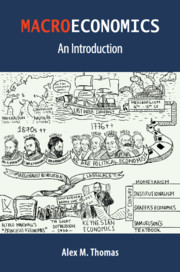Book contents
- Frontmatter
- Dedication
- Contents
- List of Illustrations
- List of Figures
- List of Tables
- Preface
- Acknowledgements
- Note to the Reader
- 1 What is Economics
- 2 Conceptualising the Macroeconomy
- 3 Money and Interest Rates
- 4 Output and Employment Levels
- 5 Economic Growth
- 6 Why Economic Theory Matters
- 7 The Policy Objective of Full Employment
- 8 The Policy Objective of Low Inflation
- 9 Towards Good Economics
- Data Sources
- References
- Index
3 - Money and Interest Rates
Published online by Cambridge University Press: 08 June 2021
- Frontmatter
- Dedication
- Contents
- List of Illustrations
- List of Figures
- List of Tables
- Preface
- Acknowledgements
- Note to the Reader
- 1 What is Economics
- 2 Conceptualising the Macroeconomy
- 3 Money and Interest Rates
- 4 Output and Employment Levels
- 5 Economic Growth
- 6 Why Economic Theory Matters
- 7 The Policy Objective of Full Employment
- 8 The Policy Objective of Low Inflation
- 9 Towards Good Economics
- Data Sources
- References
- Index
Summary
Introduction
This is the first of the three chapters in this book dealing with macroeconomic theory (the others being Chapters 4 and 5). But, given that one of the approaches adopted in this book is to combine both concept (or theory) and context, this chapter begins with an overview of India's financial architecture. Of the three ways of conceptualising the macroeconomy outlined in the previous chapter, the one pioneered by Copeland focuses on the flow of funds across sectors. Copeland's conceptualisation is complemented by the formulation in Section 2.4, where both the commodity and money flows in the macroeconomy are outlined (especially, see Figure 2.2). This chapter is an exposition of the money flows in a monetary production economy, carried out with specific reference to the Indian macroeconomy.
Revisit Figure 2.2 in the previous chapter and try to find answers to the following questions: What is the precise form in which money flows happen between the different sectors in the economy? What kinds of financial products or instruments connect you (as a member of a household) with non-financial firms? Similarly, what kind of financial instruments connect the non-financial firms with the financial firms? In what forms do the households receive wages and salaries in return for their labour? Is it in the form of cash (denominated in Indian rupee), bank deposit, company shares, foreign exchange or something else?
After answering the above-mentioned questions in Section 3.2, we move on to discuss ‘what is money’ and interest rates. Subsequently, the role of the central bank is explained with the spotlight on the Reserve Bank of India (RBI), India's central bank. The chapter ends with a section focusing on the money flows between India and the rest of the world.
The financial architecture of India
Many people rightly associate economics with the study of money and related variables like interest rates and inflation. As previously noted, the approach in this book is to understand the economic workings of a monetary production economy that is characterised by the free mobility of labour and capital. In a monetary production economy, it is imperative that the study of economics examines both money as well as commodity flows.
- Type
- Chapter
- Information
- MacroeconomicsAn Introduction, pp. 39 - 63Publisher: Cambridge University PressPrint publication year: 2021



